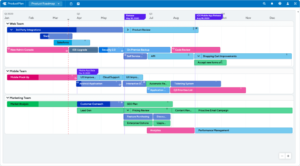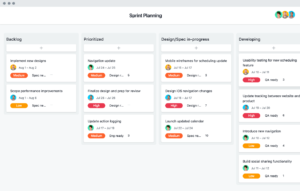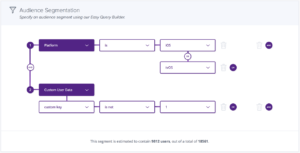How to Plan and Develop a Product Your Customers Actually Need

Developing a great product isn’t just about coming up with an innovative idea. There’s planning, research, analysis, and much more that goes into building something your customers actually need. Putting together a solid product development strategy helps you gain more insight into these customer preferences, which ensures you’re building something truly valuable.
Focusing on customer value is the first step of product development. Your strategy takes it further by codifying every aspect of the process—from inception through to release. Knowing how to build out this strategy makes the process of bringing your product to market faster, easier, and less stressful.
And with everyone aligned in the same direction, you’re able to make more of an impact on product and business goals.
Bring Your Tool to Market Faster & Easier with These 6 Steps
These 6 steps will help you to quickly and easily launch your product to market.
1. Document Your Ideas Clearly
When you work in an industry long enough, it’s easy to come up with ideas for improving your own experience. Nailing down these ideas is the first step in building out your product development strategy. That’s why it’s so important to compile these product ideas in a living document to use as a jumping-off point for further research.
Articulating these ideas helps you refine your thinking early in the product development process. And documenting everything makes workshopping an idea easier for your team. Each idea is an opportunity to share the product vision with your team, which increases visibility at the very beginning of the process and boosts engagement with the strategy across the board.
Let’s say you have a new feature idea for your SaaS metrics tool: an automated report generator. When you document that idea, it’s an opportunity to get feedback from various stakeholders across multiple teams. Your sales team can provide more context about what leads ask for in terms of reporting, and your support team can speak to the potential impact of the feature on the customer experience.
Defining a place for product documentation helps you get ideas from the rest of the team as well. Customers provide feature requests all the time, so it makes sense to add those to a living document you can revisit when you need some inspiration.
Just keep in mind that these are just ideas at this stage—to build a truly excellent product, you need to validate those ideas in some way.
2. Validate Ideas With Market and User Research
Once you’ve put together a list of ideas, it’s time to validate them to make sense of their impact on both customers and your bottom line. The best way to do this is through exhaustive market and user research. You’re going to spend a lot of time and resources developing a new product, so it’s important to have a clear sense of how that idea solves an existing problem for users.
While the market research and user research processes are similar, you need to understand what kind of information each provides for your product strategy.
- Market research: This is how you gain an understanding of industry trends. The competitors that exist, the solutions they provide, the prices they charge—all of this is valuable context for bringing your own product to market.
- User research: This is where you double down on the needs of your customers and prospects. User research tells you who wants to buy your product, what they want to pay for it, and how they’ll use it to solve a problem for their business.
Conducting this kind of research is also a great opportunity for competitor analysis. Your product development strategy needs a clear sense of what competitors exist in your market and how your product is differentiated. This is your chance to look for gaps your product can fill.
You can also flesh out your market and competitor research by tracking review sites like G2 and Capterra for feedback on existing tools. Understanding how people feel about the current products on the market helps you refine yours to better meet their specific needs.
And don’t forget to talk to your current users. There’s no better group of people to validate an idea than those who are already bought into your brand. A quick survey to your customer list via email or direct outreach to specific personas is a great way to build relationships. When combined with wider user and consumer research, their feedback also helps you build personas to target during your release.
3. Create a Product Roadmap and Vision
Once you’ve validated your idea through market and user research, it’s time plan for how you’ll create the product. This plan codifies the product development strategy into a clear roadmap to guide your path forward. It also allows you to showcase everything that’s gone into your product idea so far.
Sharing this information boosts engagement with your overall product development strategy and aligns the team on their responsibilities. As you create your roadmap, make sure to include the following:
- Timeline: How long it will take to move forward with the development process. Timelines can be framed around days, weeks, and quarters, or more broadly with a Now, Next, Later framework.
- Features: What you are planning to build. There are lots of components that need to come together for a successful product or feature release. Defining these features helps you prioritize your work based on the resources required to complete any of these individual tasks.
- Goals: The business impact of building your product. Include a mix of product-specific and overarching business goals to measure your success. It’s crucial to define specific baseline metrics to guide your execution as well.
Using the automated reports example again, let’s take a look and what building out these elements might look like:
Timeline:
- Update customer database – 8/5
- Build out graph generator – 8/22
- Design and create reports user interface (UI) – 9/3
Features:
- Customizable graph builder
- Scheduling functionality
- Previous reporting history
- Automatic month-over-month change reporting
Goals:
- Showcase the value of existing customer data
- Make it easier for customers to derive value from the tool
- Increase account engagement metrics by 5% in Q4
When you combine this information in a single roadmap document, it will look something like this:
Roadmap example via ProductPlan.
Each color represents a different feature or task, plotted against calendar dates and other work across multiple teams. Visualizing the roadmap in this way makes it easier to create a realistic timeline for your team while also tying everything back to a specific product or business goal.
In our analytics report example, we used account engagement rates as the indicator of success, but that’s just one option. Depending on the product, the goal could be to lower customer acquisition costs or increase the number of marketing-qualified leads. The metrics you choose should be directly tied back to the overall business impact of your product.
4. Define Processes for Your Team
With a plan in place, you can start establishing processes you’ll use to work through development with your team. Your product development strategy should point everybody toward a clear path forward to ensure that everyone is always in alignment with your goals.
The Agile method is one of the best ways to do this. Built to help software development teams move faster, the Agile method breaks up deliverables into time-boxed work units called sprints, making it easier for the team to see what’s required at each step of the process.
Sprint planning template via Asana.
This helps keep everyone on track and gives you the opportunity to revisit your vision, roadmap, and strategy more regularly. This increases visibility across the team and helps you identify potential issues before they become bottlenecks for your team.
When you combine this with daily stand-up meetings to communicate progress, your team can easily work through their individual responsibilities while also following along with overarching product goals.
Your product development strategy should also define how your team communicates on a day-to-day basis. What documents need to be updated with new information, how those documents are structured, who’s responsible for making changes—all this needs to be defined. How your team communicates their progress will directly impact your ability to deliver on the timeline in your product strategy as efficiently as possible.
5. Determine How You’ll Test the Product
A great product development strategy should include testing with actual users before moving forward with a full release. This is your opportunity to get feedback from a small group of people and ensure you’re building a truly valuable product before taking the product live. It’s a chance to validate the work you’ve done so far and address any potential bugs proactively.
Use feature flags to roll out the updated feature or product to specific users based on their needs. You should have a good sense of what kind of users would benefit most from your product through the user research process—this is your opportunity to leverage their feedback.
Building out a segmented audience in Taplytics.
Reach out to the same people you identified throughout the research process and ask for their feedback. It’s their chance for a sneak peek at your upcoming product release. Not only does this help you learn more about the real-world impact of your product, but it helps cement the relationship with your customers even further.
Testing with real users is also an opportunity to measure the impact of your product on the team. Monitor what happens when people use the feature and make sure it doesn’t cause downtime or additional strain on your technology. It’s important that new products don’t make it more difficult to work together as a team.
6. Prepare for Your Product Release
How you unveil your product to the market partially determines how customers perceive its value. That’s why it’s so important to include a release management plan as part of your product development strategy. This plan tells everyone what’s expected of them throughout the release process and how it impacts both team members and customers.
Scoping out your release plan in this way is also an opportunity to get marketing, sales, and support ready for the influx of potential customer questions. This lets you define the resources you need to prepare for release—whether that’s marketing content, sales training, or knowledge-base documentation for customer support. Each team involved in the release should have a clear understanding of their responsibilities leading up to and after launch day.
Include a timeline for the release with specific deliverables and fallback dates for your team. And consider phased rollouts to make the release process as seamless as possible. When you’re nearing the end of the development process, a negative release experience can cause issues with product engagement early on.
Strategy is Key to a Successful Release
When you define a clear product development strategy with actionable takeaways for your team, it helps everyone move toward the same goal. Use this strategy to increase engagement with the product development process and create a better experience for your customers and team.
Documenting your product development strategy also makes it easier to create repeatable processes for your team. As you release more products or update existing ones with new features, you can leverage your previous strategies to create a better experience with each release.
Learn More with Taplytics
Leverage Taplytics to seamlessly bring your product to market. Get started with a 14-day free trial.



